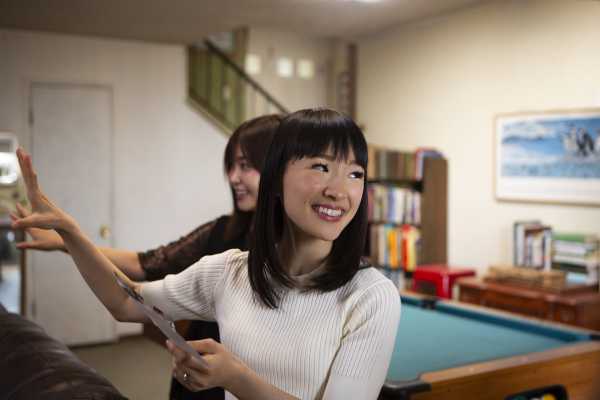
I was roughly two episodes into Netflix’s Tidying Up With Marie Kondo when an alien thought entered my brain.
Wouldn’t my life be better, I thought, if when I opened my shirt drawer, I didn’t see folded but sloppy stacks of rarely worn and sometimes hole-ridden shirts? Wouldn’t it be better if instead I saw row after row of shirts folded neatly into plump little rectangles, each standing vertically on end?
Wouldn’t it be better if they were only shirts I truly loved, without any of the weirdly shaped quasi-crop-tops I’ve picked up at clothing swaps and brought home with the vague idea that I would some day “figure out” how to wear them? And really, wouldn’t it be best of all if my neatly folded shirts were arranged in a color gradient, from dark to light?
It would be like looking at a perfectly organized rainbow, right there in my dresser drawer. I could not imagine anything in the world that could be more satisfying, and I have never had such a thought before.
I am a generally neat person. I like to sort and categorize and put things away. I don’t leave clothes on my floor or dishes in my sink. I sometimes read organizing books for fun, because I find them soothing. (Yes, I recognize that sounds a little bit sick.) I will willingly watch a show with a title like Tidying Up.
But I am not so neat that the idea of sorting my clothing into rainbows has ever appealed to me. At least, it didn’t until Marie Kondo — celebrity tidying consultant, internationally best-selling author, and star of Netflix’s new Tidying Up With Marie Kondo — beamed with serene joy, opened up a display drawer on camera, and gestured as if to say, “Look how perfect!” And suddenly the urge to organize my own dresser became nearly unbearable.
Creating this urge is the kind of thing at which Marie Kondo excels. She is brilliant at making what has previously seemed to be an ordinary, serviceable way of life seem lacking, drab, unjoyous. Or, if your life feels disastrously unorganized, Kondo promises that she can make it better. With Kondo’s trademark KonMari method, you can optimize not only your home but yourself. You can create a world in which absolutely everything around you sparks joy.
Marie Kondo is a celebrity of tidying, and yes, it turns out that is a thing
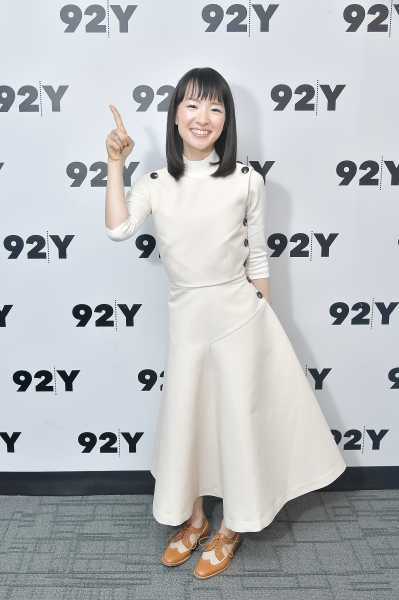
Marie Kondo started working as a professional tidier in Japan at age 19, when she began tidying up friends’ homes for extra cash. “Tidying was such an integral part of my daily life,” she writes in her first book, The Life-Changing Magic of Tidying Up, “that it wasn’t until the day I started my own business that I realized it could be my profession.” She was so successful that eventually, her waiting list contained enough names to fill six months of work; within a few years, she became a celebrity in Japan. After she wrote The Life-Changing Magic, she followed it up with a companion, Spark Joy, plus a manga adaptation and a journal.
Still, when The Life-Changing Magic of Tidying Up hit the US market in 2014, it was not a guaranteed smash. Kondo speaks little English, so there weren’t many options for a promotional tour.
But then Penelope Green picked up the book to review it for the New York Times. Under the influence of Kondo, whom Green describes as “a kind of Zen nanny, both hortatory and animistic,” Green recounts embarking on a euphoric tidying spree: “Giddy, I twirled ribbons into circles and nestled them in a drawer with a stack of tissue paper, notecards and rolls of Scotch tape. I threw lone gloves out with near drunken abandon,” she writes.
“What I loved was how quirky it was,” Green wrote in an email to Vox, recalling her 2014 review of Kondo’s book. “I loved her gentle animism, this notion that your things, even your socks, were nearly animate, and deserved compassion and respect.” (Kondo worked as a Shinto shrine maiden as a teenager, and credits that time with her tendency to treat her things as though they have feelings.)
“All that folding and twirling and stacking made my drawers and shelves and closets so beautiful. It was soothing to just look at everything all rolled up and spare,” Green recalls. She adds that she has stuck with the KonMari program: “I never looked back,” she says.
Green allows that her book review in the New York Times helped kick off Kondo’s US success but insists, “If it wasn’t us, it would have been someone else. She was already so very, very famous in Europe, Australia and back home.”
In the wake of Green’s review, Kondo and the KonMari method took off in the US. They became ubiquitous. The Life-Changing Magic of Tidying Up became a No. 1 New York Times best-seller, moving 6 million copies. Kondo appeared on Rachael Ray. Mindy Kaling joked about her on The Mindy Project. The 2016 Gilmore Girls revival featured a lengthy gag in which a grieving Emily Gilmore rid her house, per Kondo’s advice, of everything that failed to bring her joy. The secondhand clothing retailer Poshmark experienced a 60 percent jump in inventory in 2015, an increase it attributed to the popularity of the KonMari method.
And now, in the wake of Kondo’s Netflix show, which premiered on New Year’s Day, Kondo and her tidying methods are once again in the spotlight. Twitter is flooded with memes about which things do and don’t “spark joy”; all manner of websites have published article after article about what it’s actually like to KonMari your house. The show has sparked an influx of castoff clothing and accessories to New York’s trendiest thrift store. 2019 is shaping up to be the year of Marie Kondo.
Organizing is a potent fantasy because it offers the possibility of control
There have been organizing cults before. In the early ’00s, when I was in high school, the celebrity method du jour was Julie Morgenstern’s S.P.A.C.E. method. As Morgenstern explained it in her New York Times best-seller Organizing From the Inside Out, the S.P.A.C.E. method began with a lengthy psychological self-assessment to figure out what was holding you back from being your best and most organized self, and continued through a system of sorting, purging, assigning each of your things a home, containerizing, and equalizing.
The whole endeavor bore a remarkable resemblance to Marie Kondo’s method, minus the animism, and it was aiming for the same general idea: You, your stuff, and your space could all be better.
As a teenager, I used to read Morgenstern’s book every time I had a big test coming up. I found it incredibly soothing. What appealed to me was the fantasy of total control: With the help of a few easy-to-follow rules, the book promised, I could make everything around me submit to my will. I might not be able to guarantee the outcome of my schoolwork or my grades or anything else in my life, but, with this book, I could put my stuff and my space into perfect order.
The KonMari method promises the same kind of control but does it one better. Traditional organizing methods call for you to negotiate your space away from your stuff. You assume that your stuff has the right to stay, so if you want to throw something out, you have to come up with an argument for why it deserves to go: “I’ve never liked this shirt, but it’s possible that I’ll have to paint my living room sometime in the next five years, so shouldn’t I keep it just to be safe? Doesn’t it deserve to take up space in my life?” It can get exhausting.
But Kondo assumes the ideal of an empty space so that your stuff, not you, has to negotiate for the right to belong there. And just like that, your control deepens.
The KonMari method is designed to optimize joy
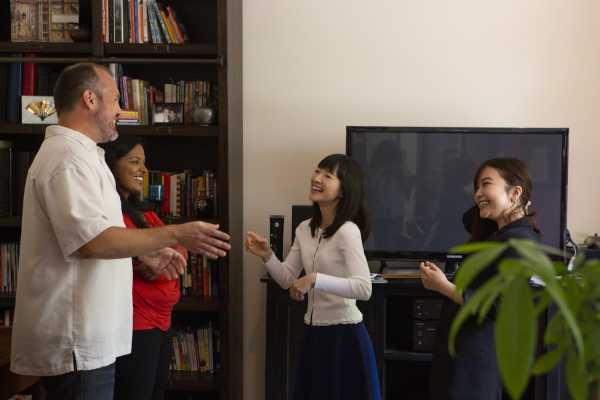
The KonMari method has essentially two parts: discarding and sorting.
First comes the discarding. You collect everything you own in a specific category — clothes, books, papers, and so on — and you heap it into an enormous pile on the floor. You stare at the mountain of stuff and you feel, deep in your soul, how much stuff you have and how unnecessary most of it is.
You pick up each thing and you ask yourself: Does this spark joy in my life? If it does, Kondo says, you will know. There will be a physical reaction in your body, a feeling that Kondo describes on her show by pointing one finger into the air, kicking the opposing foot off the ground, and chiming, “Ting!” like an adorable egg timer.
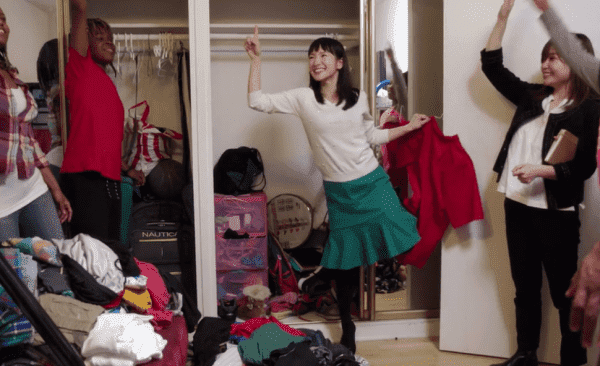
If the item sparks joy, you may keep it. If it doesn’t, you are instructed to thank it for everything it has brought to your life — even if it has only taught you that you don’t actually like items like that — and then you discard it.
Once you have pared away all of your excess items, you may put away what remains. Kondo recommends doing so thoughtfully, with attention to what fits your stuff and what fits your house.
“Every piece of clothing has its own ‘sweet spot’ where it feels just right — a folded state that best suits that item,” she writes. It’s a spot where “the piece of clothing keeps its shape when stood on edge and feels just right when held in your hand. It’s like a sudden revelation — So this is how you always wanted to be folded! — a historical moment in which your mind and the piece of clothing connect.”
For KonMari skeptics, this gentle animism is the kind of thing that leads people to nod along with Nicole SIlverberg at GQ and say, “I mean … I love you, girl, but no.” But even Silverberg was won over eventually. When she KonMari’d her house, she held off on thanking her clothes as she discarded them, “mostly because it’s dumb,” she writes, but then she accidentally thanked one of her favorite shirts as she threw it out.
“Then something magical happened: I felt at peace with its disposal,” Silverberg writes. “I thanked each special item, and I really meant it.”
Clothes aren’t the only things that have feelings, according to Kondo. Your house does too, and you must follow your house’s guidance to see what fits where. Still, she suggests that certain methods of sorting tend to spark more joy than others. Clothes arranged in a drawer on a color gradient are joyful. Clothes hung in a closet in size order — longest on the left, shortest on the right, so that their bottom hems form a diagonal line pointing upward — are joyful. And if you’re going to doubt Kondo’s word on that, well, why are you even bothering to pick up her book?
“Some may question whether paying attention to such details can possibly cause such a change,” she writes, “but why waste your time doubting if incorporating this exciting magic into all your storage spaces could keep your room tidy?”
In her books, Kondo tends toward rigid prescriptions — never ball up your socks, always discard papers — with the caveat that you should ultimately follow your own instincts about what will spark joy for you. But on her Netflix show, the rules are looser. When a grieving widow says that she wants to tidy her late husband’s clothes at the beginning of the process, rather than at the end, as Kondo suggests, Kondo nods in understanding. “Thank you for helping me to understand you better,” she says.
The entire process should be done in one fell swoop, never incrementally, she says in The Life-Changing Magic. Done properly, Kondo estimates that it should take about six months, and while she allows that this might seem like a long time, really, “it is only six months out of your entire life.” Once it’s done, she maintains that you will never have to tidy again: “I never tidy my room,” she proclaims in the book. “Why? Because it is already tidy.”
“You are, after all, tidying up your own life. That brings stuff up.”
Despite what Kondo says, in practice, many of the KonMari devotees I’ve spoken to have said that they have to repeat the process periodically.
“I KonMari’d my former apartment a few years ago when her book first came out, and by the time I moved out a few years later, I had for sure amassed more stuff. The show has inspired me to do another full KonMari,” says writer and librarian Ann Foster. “I don’t think, like any extreme solution, it can possibly change my entire lifestyle. So maybe a ‘cleanse’ every few years to keep things in check?”
“I think KonMari fixed my apartment but not necessarily me,” says digital marketer Val Bromann. “I’m still the same person who hates doing dishes and lets them pile up in the sink and throws her dirty laundry on the floor. So more often than not my apartment isn’t perfect, but it’s definitely better than it was before.”
Even those who have kept up with the method acknowledge that the maintenance required is intense — “It’s a lifestyle choice, for sure,” says publicist Rachael Shearer — and for some, that was what kept the method from working out long-term.
“It was helpful but it didn’t last,” says chef Julia Helton, who identifies as a “clutter-type person.” “Her thing is a skill set but it’s also a behavior you must be willing to adopt on the daily.”
What nearly everyone who loves the KonMari method repeats, however, is that it has fundamentally changed their relationship with their stuff.
“My consumption habits actually did radically change after I did the whole method the first time,” says magazine marketer Nora Revenaugh. “I now check in with my values and my gut feelings before I bring anything into my house.”
“When I’m doing something small like clearing out the leftovers in the fridge, I’ve become more intentional about why I save what I save,” explains writer and editor Haley ED Houseman. “Am I really going to eat this half-serving of pasta this week? Probably not.”
For the KonMari fans I talked to, what is most appealing about the method is that it is framed so positively: You’re not tossing away dead weight, just recognizing what sparks joy for you. Understood properly, they say, KonMari is less about throwing out most of your stuff and more about checking in with your priorities.
“She’s not inherently minimalist. She encourages you to keep things that make you happy, even sentimental items,” says Houseman. “I never felt pressured by the method to get rid of things I enjoy having in my house.”
“I like her method over others because it never makes me feel bad for owning so many things,” says Foster. “It’s focused on the joy I get from the things I love, and even the way she approaches getting rid of things — not calling it crap or tossing it away, but expressing gratitude and sending it away gently — makes it a positive experience.”
Shearer notes that a lot of organizational methods don’t make space for dealing with sentimental items the way KonMari does: You’re encouraged to think of organizing as getting rid of the dead weight in your life by “purging,” not by respectfully closing the door on something that no longer works for you. “Organized people already know how to tidy and declutter, but this method lets you have feelings about it. Actually, it encourages you to have feelings about it,” she says. “That appeals to me. I don’t like to tidy like a robot. You are, after all, tidying up your own life. That brings stuff up.”
For Kondo, tidying is magic
Marie Kondo is not only selling a tidying method, though. What is perhaps more important for her brand — and is definitely more important for the Netflix show — is that she is selling a fantasy. She is selling the fantasy of a tidy life.
Even before the Netflix show premiered, spectacle was a major part of the KonMari fantasy. Kondo’s Instagram is filled with picture after picture of properly KonMari’d interiors, shelves and drawers with everything arranged just so in order to best spark joy, and the effect of scrolling can be to experience a feeling of near ecstasy. Look at those perfect stacks, the perfect boxes, the empty space. Look at this perfectly regimented and controlled environment.
On Tidying Up, the spectacle continues and evolves to take on a clear narrative shape. After the camera has panned ominously over vast collections of Nutcracker figurines and overstuffed closets, after the talking head interviews in which married couples snipe guardedly at each other over whose fault the mess is, after the tension and misery created by a messy life has been established — in swings Marie Kondo, in crisp and immaculate white. She will show you how to fix the mess.
Tidying Up loves to play with the visual contrast between Kondo and the messes she cleans up. She is short — just 4-foot-8 — and next to the giant piles of stuff the KonMari method produces, she looks even shorter. Her work clothes are always white (“It is part of my brand”) and business casual (out of respect for the house), and as each episode’s family grows progressively sloppier and more disheveled while they work their way through the KonMari process, Kondo seems to become ever more pristine. She is tidiness personified.
And because tidiness here is supposed to produce joy, she is joyful. “I love mess,” she exclaims in the show’s opening sequence, and she responds with pleased gasps to each messy room she encounters. But that is nothing compared to her delight at the end of each episode, when the tidied house is revealed: She jumps gleefully onto the newly bare floor, crowing with joy about how much better everything is now that it is tidy.
The implication is, now that the family of the week has tidied their home, they have tidied their lives as well, and at last they have the chance to become as joyful as Kondo. The widow found a way to process her grief over her husband’s death as she tidied away his clothes. The young couple, stressed out by their toddlers and overwork, were able to bond as a family by tidying together. The retired couple who hadn’t yet cleared away their years of accumulated stuff were able to set the stage to enter a new part of their lives together.
In The Life-Changing Magic of Tidying Up, Kondo promises even more dramatic results from tidying. If you tidy properly, you will become thinner and your skin will clear up, she writes. You will be spiritually fulfilled and develop good fortune. You will face your anxieties about the past and the future and learn what it is that you really want from life, and at last, your real life will begin. Tidying, after all, is magic. It will open up your life to true joy.
Here’s the thing: Do we really have to orient everything in our lives around joy?
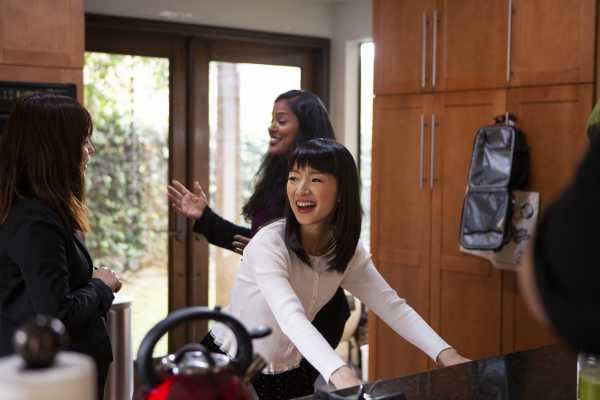
But the idea of optimizing your life to spark joy isn’t an unalloyed good for everyone. Since Kondo’s rise to fame in the US, again and again, a repeated criticism of the KonMari method has emerged: Can’t we make room in our lives for feelings besides joy?
Book people, especially, have balked at the idea that they should dispose of any books that don’t spark joy. “Literature does not exist only to provoke feelings of happiness or to placate us with its pleasure; art should also challenge and perturb us,” writes Anakana Schofield at the Guardian. “I can’t imagine what a blank collection of physical books I’d be left with if they had to spark joy.”
KonMari devotees argue that this objection emerges from an unnuanced understanding of Kondo’s philosophy. At no point does Kondo tell us that difficult things are bad: If we love books that challenge us, then those books are bringing us joy, and we can keep them. We can find joy in books that bring us sorrow and anger and rage and all kinds of emotional registers. (Kondo does write in The Life-Changing Magic that “in the end, you are going to read very few of your books again,” and she puts it in bold type so you know she means it — but she also says that if your books are sparking joy for you, then you should by all means keep them.)
Still, objectors say, isn’t Kondo’s relentless focus on joy above all else just a little bit … flattening?
In a profile of Kondo written for the New York Times Magazine in 2016, Taffy Brodesser-Akner describes losing all of her childhood possessions to a fire in her parents’ home when she was 19 years old. “I try to think of who I’d be if I weren’t in the habit of looking at my home before I left it each day and mentally preparing myself for the possibility that nothing I owned would be there when I got home that night,” she writes. “I try to know what feelings my lost objects, which I forget more and more as the years pass, would evoke if I could hold them in my hands, KonMari style, like a new kitten. Some would bring joy and some would not, but I’m not someone who thinks that joy is the only valid emotion.”
Is joy the only valid emotion? When we KonMari our lives, are we closing ourselves off to other emotional experiences that we could mediate through our stuff?
Do we really need to make everything in our lives bring us joy? Isn’t that exhausting? Isn’t the need to optimize every last goddamn thing in the world, including all our stuff, one of the things that leads to millennial burnout? If, as Anne Helen Petersen theorized at BuzzFeed, millennials are burnt out on life “because [we’ve] internalized the idea that [we] should be working all the time,” and that this is because “everything and everyone in [our lives] has reinforced it — explicitly and implicitly — since [we were] young,” then can’t we just let our stuff be stuff, not a means to achieving and maximizing joy? Can’t things just be a little bit crappy sometimes without it feeling like a major failing?
And what if the problem in our lives isn’t that our stuff is blocking us from joy? That’s one of the reasons KonMari is rarely recommended for people who are dealing with mental health issues: If you have a hoarding disorder, the problem you’re facing may be instead that, as one woman put it to the Atlantic in 2016, “Everything fucking gives me joy!”
And how does the KonMari method work for practical things, the things that we have to keep around the house because we need them but that might not be joyful to us? What do I do if my frying pan doesn’t spark joy for me? Should I throw it out and replace it with a shinier, prettier, more functional version? Should I stop cooking dishes that require it?
This problem of practicality is where we get to one of the hidden traps of the KonMari method: While it’s sometimes thought of as the philosophy of a minimalist, anti-consumerist lifestyle, it’s not. It’s actually extremely expensive. If I want everything around me to make me joyful — including my cleaning supplies, including my kitchenware — then I can discard what I don’t like, sure, but at a certain point I’ll have to get new versions of the stuff I actually need, versions that will spark joy for me. And the replacements I bring into my home will cost money.
“Maybe you really hate your refrigerator — it came with your house and it’s an off-yellow color side-by-side that can’t even hold a good-size frozen pizza in the freezer. But that doesn’t mean you can get a new one; you need something to keep the milk cold in,” writes David Minerva Clover at Ravishly. (Clover adds that he nevertheless is a fan of KonMari, and that in his own practice, he uses an “an expanded and loosey-goosey definition of the word ‘joy’” that allows him to find joy in the idea of a functional toilet.)
This dilemma is part of why, when Kondo sold storage boxes that started at $89 for a set, it was not antithetical to her philosophy at all. (While The Life-Changing Magic dictates that KonMari followers should not buy new containers for storage but just use whatever they have around the house, Kondo says she later realized that US packaging materials weren’t on the same level as Japanese packaging, which is why she started her own housewares line.) Her $89 boxes were aesthetically pleasing in the way that a shoebox of the same size and material is not, which meant that they could spark more joy than a shoebox could. That’s presumably why they sold out.
If you want to surround yourself only with things that spark joy, if you don’t want to just live with a lot of average to mildly crappy stuff that still gets the job done, if you want that beautiful $89 set of boxes instead of using a few free shoeboxes instead — well, that takes money. A lot of it.
And yet for all of the perfectly valid and reasonable objections there are to KonMari, they don’t seem to affect the potency of Kondo’s brand. Marie Kondo is tidying. She is perfectly ordered shelves and immaculate white business casual; she is the question, “Does this spark joy?”
That’s because, for the purposes of her brand, what matters is less the efficacy of her method and more the fantasy that she is selling: the fantasy of that perfect drawer, with the shirts lined up in a beautiful, regimented rainbow. A tidy life, and a world under perfect control.
Sourse: vox.com






